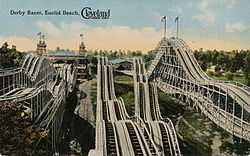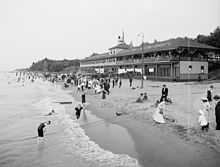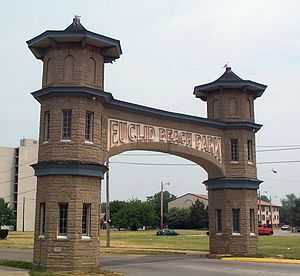Euclid Beach Park
 Euclid Beach post card, circa 1915, featuring the roller coaster, Derby Racer (later renamed the Racing Coaster) | |
| Location | Cleveland, Ohio, United States |
|---|---|
| Coordinates | 41°34′48″N 81°34′12″W / 41.580°N 81.570°WCoordinates: 41°34′48″N 81°34′12″W / 41.580°N 81.570°W |
| General Manager | William R. Ryan, Sr. |
| Opened | 1895 |
| Closed | September 28, 1969 |
Euclid Beach Park (1895 – September 28, 1969) was a popular amusement park located on the southern shore of Lake Erie in the Collinwood neighborhood of Cleveland, Ohio.
Originally incorporated by investors from Cleveland and patterned after New York's Coney Island, the park was managed by William R. Ryan, Sr., who ran the park with featured attractions including vaudeville acts, concerts, gambling, a beer garden, and sideshows as well as a few early amusement rides.[1] In 1897, Lee Holtzman became Euclid Beach's new director, but he offered it for sale in 1901.
Dudley S. Humphrey, Jr. led six members of his family in undertaking management of the park as of 1901 (they had previously operated concessions at the park, but had been particularly unhappy with the way Ryan ran it). They expanded the beach and bathing facilities, including adding a lakeside swing, added many new attractions, and advertised to locals with the slogan, "one fare, free gate and no beer." [2]
Designed to be a family-friendly park, the Humphreys would not admit anyone who had consumed intoxicating beverages at a bar directly across the street from the entrance to the park.[1] Signs throughout the park instructed that only children were permitted to wear shorts, because the Humphreys thought that proper dress would promote a family-friendly atmosphere.[1] At one point the park advertised that it would "present nothing that would demoralize or depress," and that visitors would "never be exposed to undesirable people."[3] In August 1910, the park was the site of an exhibition flight by aviator Glenn Curtiss from Euclid Beach to Cedar Point and back.
Rides and attractions
Euclid Beach Park was built abutting a beach on Lake Erie, which was part of the attraction, and, for a time, a principal part of the Park's attraction. An early addition to the park was its famed dance hall. After the Humphreys acquired the park, many more attractions were made part of Euclid Beach.

The Euclid Beach carousel
The first carousel to be installed at Euclid Beach Park was the Philadelphia Toboggan Company Carousel Number 9 design. It debuted in 1905; in 1910, it was replaced by Philadelphia Toboggan Company Carousel Number 19. This carousel had fifty eight horses and two chariots, which were decorated with leaf carvings surrounding a Greek god and two cherubs. The chariots retained these classic designs when the carousel's other decorations were replaced with ones having an art deco motif.
After Euclid Beach Park ceased operation, this carousel was sold and moved to Palace Playland in Old Orchard Beach, Maine, where it operated until 1996. In 1997, the Euclid Beach Park Nuts (today called Euclid Beach Park Now) and the Trust for Public Land partnered to acquire the carousel and bring it back to Cleveland. It is not currently operating and the horses and mechanism have been placed in storage although several of the horses have been brought out and put on display for short periods of time. On June 30, 2010, the Western Reserve Historical Society (WRHS), which owns the carousel horses, chariots, and mechanism, announced a collaboration with Cleveland's Euclid Beach Park Carousel Society and Euclid Beach Park Now to restore, reassemble, and operate the carousel at the Historical Society's location in University Circle.[4] The plan envisions a $6 million fund-raising campaign to pay for the project, including the construction of a pavilion to house the restored ride, and provide an endowment to ensure its operation into the future.
Since that time, the Euclid Beach Carousel Society entered into a contract with a firm which designs and builds new wooden carousels as well as restores old carousels. The Carousel Works of Mansfield, Ohio was given the task of coming as close as possible to restoring the ride to its original appearance and function,[5] a process which was found to essentially require the remanufacturing of the ride because of damage said to have occurred during the transport of the components from Maine back to Cleveland.[6] On Tuesday, April 17, 2012 the WRHS broke ground for the construction of a glass pavilion to house the restored and reassembled carousel.[7] Both construction and restoration are expected to be completed by 2014.[8]

Roller coasters
Seven roller coasters operated at Euclid Beach in the history of the park. All were wood coasters. The first roller coaster, the Switchback Railway, debuted in 1896 and closed in 1904. It was built by LaMarcus A. Thompson.
The Switchback Railway was followed by the Figure Eight (1904—1909, designed by Henry B. Auchy and built by Philadelphia Toboggan Coasters) and the Scenic Railway, the second coaster to be built by Thompson (1907—1937).
In 1909, John A. Miller premiered his first coaster at the park, the New Velvet Coaster, later renamed the Aero Dips, which ran until 1965. He also designed the Derby Racer, later renamed the Racing Coaster, which was built by Frederick Ingersoll and debuted in 1913 with much fanfare, including a quite favorable advertisement in the May 30, 1913 Plain Dealer. This was the first roller coaster to last until the close of the park in 1969. This coaster only had a single track, which formed a moebius loop. Miller would later co-design the Flying Turns (see below).
The Thriller was designed by Herbert Paul Schmeck and Howard Stoneback. It, too, was built by Philadelphia Toboggan Company. Premiering in 1924 and surviving until the close of the park, it was one of the most popular coasters around in its heyday. It was an "out and back" coaster, and it cost $90,000.
The Flying Turns
The Flying Turns was the name of a roller coaster at Euclid Beach Park, but it was also the name for a type of roller coaster. John Norman Bartlett, a British aviator in World War I, came to North America after the war with an idea for a trackless wooden chute, full of twists like a bobsled course, with toboggan-like cars. He filed a patent for the idea in 1926.
Bartlett met John Miller in 1928, and they commenced building the new ride. When the ride went into production, much of the idea was the same, but the cars looks more like monoplanes, which Bartlett designed. Miller worked on the loading station, supporting structure, braking system and incline.
The first Flying Turns ride was built and operated at Lakeside Park in Dayton, Ohio. The Flying Turns at Euclid Beach Park was the second to be built (there would later be a half-dozen more, including one at Coney Island). It was also the tallest, and the Park's version used three-car trains. Couples enjoyed the ride because one rider could sit in the other's lap. "At Euclid Beach on the Flying Turns I'll bet you can't keep her smilin'" is a line from the Beach Boys' song "Amusement Parks U.S.A." (from their 1965 album Summer Days (and Summer Nights!!).
The Euclid Beach Park Riot
By around 1915, Euclid Beach Park would only admit African Americans on certain days as part of its efforts to promote what its management saw as a family-friendly atmosphere. On the other days, the park's special police enforcement team would see to the exclusion of blacks entirely. On the days when blacks were allowed into the park, they were not permitted to interact with white park-goers.[2]
A series of protests occurred at Euclid Beach Park in 1946. On July 21, 1946, twenty people from American Youth for Democracy, United Negroes and Allied Veterans of America, and the National Negro Congress visited the park as an interracial group. They were evicted after a park policeman told them that it was park policy that there be "no sitting, no talking, no mixing of any kind... between the races."[2] Subsequently, Euclid Beach Park was picketed on several occasions by these and other organizations.[2]
On August 23, 1946, twelve members of the Congress of Racial Equality (CORE), another interracial group, attempted to visit the park, but were also ejected by park police. Albert T. Luster, an African-American man who had gone to the park to meet the CORE group but never actually met with its members, was later beaten by a park policeman.[2]
CORE continued to fight the segregation policy. A six-member interracial group from CORE visited the park on September 21, 1946, and were again removed from the park by the park police. However, on this occasion two off-duty Cleveland policemen, Lynn Coleman and Henry MacKey, both African-American, intervened and a fight broke out between the city police and the park police. In the scuffle, Coleman was shot in the leg with his own gun. After this incident, the park closed a week early, per the Mayor's request.[2]
Decline and closure

Euclid Beach Park closed forever in September 1969, after the summer season. It was one of many aging parks from another era which closed during the 1960s. The Forest Park Highlands in Missouri burned down in 1963 never to be rebuilt, New Jersey's Olympic Park closed in 1965 due to blight. Riverview Park of Illinois shut down in 1967 due largely to operating and maintenance costs.[9]
Some rides or other attractions were placed in operation at other locations. Many of the Kiddy Rides, such as the Euclid Beach Chief, were sent to Shady Lake Park in Streetsboro, Ohio.[10]
- The Great American Racing Derby, a ride which simulated a horse race, still operates today as Cedar Downs Racing Derby at Cedar Point in Sandusky, Ohio. It is listed on the National Register of Historic Places.
- Laffing Sal, the robotic nightmare that greeted patrons of the Surprise House, still haunts Cleveland, and is rented for many occasions such as parades and Home Days in some suburbs.[11]
Many structures still standing on the Euclid Beach site after its closing, including the famous dance hall, were destroyed in a series of arson fires.[citation needed] The suspects were never apprehended. By 1986, most of the park was gone, though some remnants of the park are still visible to this day.[12] The original shoreline walkway is still at the beach, the concrete pier which was made with a patented Humphrey concrete-pouring process is also standing at its original location and a number of other artifacts can still be seen there.[13][14] This process was also used in constructing the trailer park wall, which is still standing. The wall runs along Lakeshore Boulevard.
A few original guy-wire remnants attached to the sycamore trees remain along with the loading platform for the Antique Cars, the anchor post for the Thriller coaster, and part of the path to the Flying Turns platform. The bridge for the Turnpike Cars still stands across the driveway for one of the apartment buildings built on the former west end of the Park and the remains of the supports for the Turnpike Cars center directional rail which was used on the track to keep the turnpike cars from going off of the track are also still visible.
Next to the pier, of which the concrete portion is largely intact, sits an empty, circular cement pool which was once a ride. Beach-goers could sit in suspended swing seats, and be taken for rides around the 2-foot-deep (0.61 m) pool via a motor in the pool's center. Later, the swing seat apparatus was removed, and a center fountain was put in its place. The pool is now filled in with dirt and grass. Plans are to rebuild the Pier.
Perhaps the most famous of the remnants of Euclid Beach Park is the arched main gate. This archway has been declared a Cleveland landmark, and is now protected from demolition. The arch was severely damaged by a hit-and-run driver in January 2007.[15] On June 12, 2007, the rebuilt Arch was rededicated.
Today, the former entrance road into the park is E 159th St. The portion of the site not included in the State Park is occupied by a trailer park, and the owners of the trailer park demolished the Humphrey Mansion in 2005.[16]
The Humphrey Company[17] continues to sell the popcorn and taffy products made famous during the heyday of the park.
The 2007 documentary Welcome Back Riders featured Euclid Beach.
Euclid Beach also featured in an episode of the classic television series, Route 66, in which a young boy runs away from home and spends the day in the park.
Inspired by their recollection of the famous Euclid Beach frozen custard, two Cleveland area men set out to learn as much as they could about making this old-time treat. In 1985, they opened their first East Coast Frozen Custard store in Parma Heights, Ohio and have opened a small number of stores in other locations in Northeast Ohio since that time. They have credited the success of the chain to the ability of their product to revive customer memories of Euclid Beach Park.[18]
Notes
- ↑ 1.0 1.1 1.2 Bush, Lee O.; Chukayne, Edward C.; Hehr, Russell Allon; Hershey, Richard F. (1977). "1, 2". EUCLID BEACH Park is closed for the season. Cleveland, Ohio 44107: Dillon/Liederbach, Inc. Book Publishers. pp. 1–14, 21, 33, 54. ISBN 0-913228-22-2.
- ↑ 2.0 2.1 2.2 2.3 2.4 2.5 Van Tassel, David D. and John J. Grabowski, eds. The Encyclopedia of Cleveland History 2nd ed. Indianapolis: Indiana University Press, 1996.
- ↑ Francis, David & Diane. Cleveland Amusement Park Memories, Gray and Company (2004).
- ↑ "Western Reserve Historical Society Collaborates on Rebuild of Historic Euclid Beach Carousel in its University Circle Complex". WRHS Press Release. Western Reserve Historical Society. 30 June 2010. Retrieved 5 August 2012.
- ↑ Theiss, Evelyn (4 July 2010). "The Euclid Beach carousel: Whatever happened to ...?". The Plain Dealer. Retrieved 5 August 2012.
- ↑ Ewinger, James (April 25, 2013). "Euclid beach Carousel restoration a step closer with fund drive (gallery)". The Plain Dealer. cleveland.com - Cleveland Live LLC. Retrieved 30 April 2013.
- ↑ Kaczynski, Dawn (18 April 2012). "Construction begins on Euclid Beach carousel restoration project". University Circle Inc. Retrieved 5 August 2012.
- ↑ Podolski, Mark (26 April 2013). "Euclid Beach Carousel Restoration Takes Big Step Forward". The News-Herald. Retrieved 26 April 2013.
- ↑ Riverview Park - Chicago, Illinois, accessed 21 May 2012
- ↑ Timeline - Euclid Beach (1978), accessed 21 May 2012.
- ↑ http://www.laffinthedark.com/articles/sal/sal7.htm
- ↑ Illicit Ohio Euclid Beach Park page, accessed 15 March 2009.
- ↑ US Patent 1255750 Concrete Conveying and Mixing Machine, accessed 15 October 2010.
- ↑ Bush, Lee O., Edward C. Chukayne, Russell A. Hehr, and Richard F. Hershey. Euclid Beach Park Is Closed for the Season. Dillon/Liederbach, 1977. p. 36.
- ↑ Summers, Dave. "Euclid Beach Park arch damaged", WKYC. 2007-01-11.
- ↑ O'Mara, Michael. "Old Humphrey Mansion demolished", WKYC. 2005-09-15.
- ↑ The Humphrey Company, accessed 15 October 2010.
- ↑ "Our Story". East Coast Original Frozen Custard website. Retrieved 11 September 2012.
Further reading
- Bush, Lee O., Edward C. Chukayne, Russell A. Hehr, and Richard F. Hershey. Euclid Beach Park Is Closed for the Season (1977). ISBN 978-0-913228-22-7
- Bush, Lee O., Edward C. Chukayne, Russell A. Hehr, and Richard F. Hershey. Euclid Beach Park, A Second Look (1979). ISBN 978-0-935408-01-0
External links
| Wikimedia Commons has media related to Euclid Beach Park. |
- Euclid Beach Park Now
- Encyclopedia of Cleveland History: Euclid Beach Park
- Encyclopedia of Cleveland History: Euclid Beach Park Riot
- Euclid Beach Park Redux
- Euclid Beach Park at the Roller Coaster DataBase